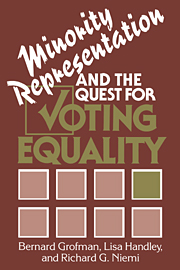Book contents
- Frontmatter
- Contents
- Acknowledgments
- List of Tables
- Introduction
- 1 The Right to Vote and the Right to Representation
- 2 The Evolution of a Vote Dilution Standard Through 1986
- 3 The Vote Dilution Standard in the Post-Gingles Era: Clarifications and Complications in the Lower Courts
- 4 Defining and Measuring Racially Polarized Voting and Other Elements of the Totality of the Circumstances
- 5 Vote Dilution in Single-Member Districts and Other Issues of the 1990s
- 6 The Voting Rights Act and the Realistic Politics of Second Best: An Optimistic Look to the Future
- Notes
- References
- Index of cases
- Index
4 - Defining and Measuring Racially Polarized Voting and Other Elements of the Totality of the Circumstances
Published online by Cambridge University Press: 18 March 2010
- Frontmatter
- Contents
- Acknowledgments
- List of Tables
- Introduction
- 1 The Right to Vote and the Right to Representation
- 2 The Evolution of a Vote Dilution Standard Through 1986
- 3 The Vote Dilution Standard in the Post-Gingles Era: Clarifications and Complications in the Lower Courts
- 4 Defining and Measuring Racially Polarized Voting and Other Elements of the Totality of the Circumstances
- 5 Vote Dilution in Single-Member Districts and Other Issues of the 1990s
- 6 The Voting Rights Act and the Realistic Politics of Second Best: An Optimistic Look to the Future
- Notes
- References
- Index of cases
- Index
Summary
As early as the mid–1970s, racially polarized voting was recognized as an important evidentiary element in challenges to at-large/multimember districting systems as well as in some cases involving retrogression and annexation (e.g., Beer v. United States, 1976; Wallace v. House, 1975). By the mid–1980s, it was identified by the Eleventh Circuit Court of Appeals as “the keystone of a dilution case” (United States v. Marengo County Commission, 1984, p. 1566), and as discussed in Chapter 2, the Supreme Court in 1986 made it the foundation for two of the three prongs of the Gingles test (Thornburg v. Gingles, 1986).
Yet racially polarized voting is not self-evident. Because individual voting records are secret, one cannot immediately determine whether minorities and whites vote for the same or for different candidates. Some analytical techniques are required. Moreover, once the data are in hand, they must be interpreted. Just what analytical techniques should be used and how the data are to be interpreted have sometimes been major bones of contention between plaintiff and defendant attorneys and among the social scientists testifying on opposite sides in voting rights cases. With the ruling in Gingles that bivariate analysis is an appropriate tool and that data obtained by “ecological” analyses are acceptable, many of these disputes have been settled. Consequently, what we present here are now generally regarded as the standard methods to be used for determining the presence of racial polarization.
Information
- Type
- Chapter
- Information
- Minority Representation and the Quest for Voting Equality , pp. 82 - 108Publisher: Cambridge University PressPrint publication year: 1992
